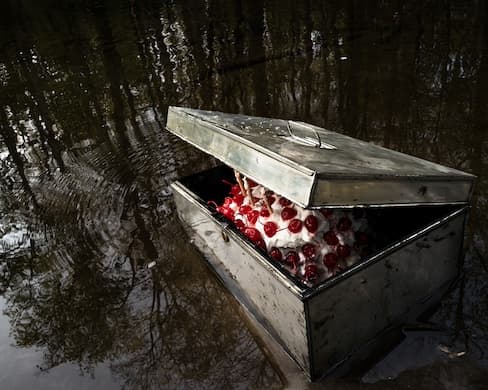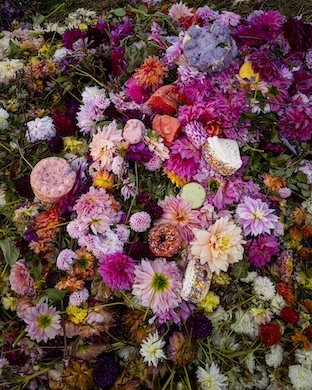Photographer Cig Harvey’s Latest Could Sit Nicely in a Museum of 17th Century European Still-Lifes
An appreciation for material sensuality filters through Harvey’s pictures. Textures are finely wrought; romantic portent is inescapable; and color ‘is a perception in the brain’ that she brings to almost otherworldly saturation.

‘Cig Harvey: Feast’
Robert Mann Gallery
14 East 80th Street
The photographer Cig Harvey is having a New York moment. She’s one of 14 artists included in “Human/Nature: Encountering Ourselves in the Natural World,” a group show at Fotografiska on Park Avenue South. Even better, Ms. Harvey is having a concurrent solo exhibition at Robert Mann Gallery on the Upper East Side, “Cig Harvey: Feast.”
“Feast” is an exemplary introduction to the British-born photographer who now calls home the hinterlands of Maine. Her work has been exhibited internationally and is represented by a host of commercial galleries across the country. Ms. Harvey’s fourth outing with Mann is up-and-running until April 5.
“Feast” plays off the title conceit in a relatively straightforward manner, what with the work’s emphasis on fruit and cake. Ms. Harvey credits her fascination with the latter to her daughter, who began making extravagant cakes some years back. Taken with the metaphorical capabilities of the subject, as well as the inescapable tension that can accrue between pleasure and guilt, Ms. Harvey began taking pictures. Are the resulting images of sweetmeats the envy of professional food photographers? Likely not: Ms. Harvey’s photos have about them the distinct air of memento mori.
In that regard, the pictures can be slotted within the trajectory of European still-life painting, of objects being employed as symbolic embodiments for the consequences, shortcomings, and rewards of experience. Seventeenth-century Dutch painting is particularly relevant upon considering the meticulous nature of Ms. Harvey’s art. “The Banquet, Camden, Maine” (2023), with its resplendent outlay of foodstuffs illuminated by keening trails of candlelight, would not look out of place next to the stray canvas by Abraham van Beyeren or Rachel Ruysch. Exactitude is the rule; sensation, the leitmotif.

An appreciation for material sensuality filters through Ms. Harvey’s pictures. Textures are finely wrought; romantic portent is inescapable. As for chroma, though light may be a “physical entity … color is a perception in the brain” that Ms. Harvey brings to almost otherworldly saturation: in the effusion of yellow-green that settles over “Gold Road, Camden, Maine” (2022), say, or the silty violet that is at the core of “Wisteria, Camden, Maine” (2021). There is, in Ms. Harvey’s photos, no divide between the mundane and the magical.
Ms. Harvey’s compositions veer from an acceptance of natural events (a field of flowers; fish in a pond) to the blatantly choreographed: the legs of a young woman in a grassy field or, say, cake placed in a metal box floating in a pond. Either way, the tableaux are weighted with meaning even if the nature of that meaning eludes explicit or rational explanation.
“Cake and Dahlias, Camden, Maine” (2023) is the most over-the-top of the pictures, being a clustered abundance of sugar, sprinkles, flour, and flora that only begins to hint at impermanence as its contents edge toward the periphery of the composition. Here, Ms. Harvey’s “primal roar” is at its most exorbitant and lush, being of a piece with an exhibition that is, at once, sumptuous and sobering.

